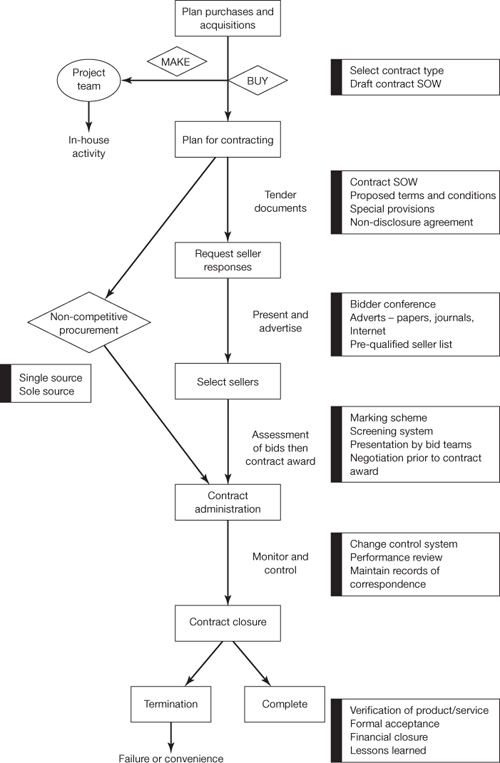Steps in project procurement management
|
|
Figure 12.1 shows the full sequence of processes and activities in project procurement management.
Figure 12.1. Project procurement management sequence of processes and activities
First steps: planningThe very first step, before even starting the process of purchasing a product or service, is to ensure that as project manager you know the organization's procurement and approval process. If you don't know these, then at best you will duplicate work unnecessarily, you will most probably do a worse job of procurement than the established organization would, and at worst you may create legal liability and risk for you personally. If time permits you should ensure that you have a rough understanding of the terms and conditions included in your organization's standard procurement contract. If you don't already know these things, then finding them out is also a way to start developing a working relationship with key people in your organization's procurement department. If you know these things but don't have those relationships, asking again is one way to start to develop them. The first two steps in project procurement management (after ensuring that you know your own procurement organization) are:
The objective of procurement management is to procure a product or service necessary to the project. This begins with the first of the six procurement management processes, 'plan purchases and acquisitions'. In this process you decide what goods or services to procure for the project, and how to procure them. It will help to understand why each good or service needs to be procured, that is, how each relates to the final deliverable and business purpose of the project. You should already understand this as project manager, but if you delegate the procurement process, which you might on a large or complex project, you should ensure that the person or team to whom you delegate also has the appropriate understanding. Planning may need to include generating options for procurement and selecting between them, and identifying potential suppliers. Another decision which may need to be answered in the procurement planning process is the make-or-buy decision. This is a classic general management decision, and it arises in project management too. Table 12.2 gives an example of the make-or-buy decision, highlighting the very common and potentially career-fatal risks in it for project managers, and showing how to manage them down to safe levels.
Planning needs information as an input. Key documents for use as input into the project procurement management processes are:
Once the plan purchases and acquisitions process is completed, or underway, the next process in project procurement management is 'plan for contracting'. The purpose of this process is to produce:
Prospective suppliers, whether sole suppliers or in a competitive bid, need information about the project's requirements of them, and eventually will need a statement of work and terms and conditions. This information is contained in the procurement documents, which terms may include, for example, requests for information (RFIs), requests for quotations (RFQs), and invitations to tender (ITTs). The details of how to attract and evaluate bidders are the heart of the procurement or purchasing management profession, and fall outside the scope of this book. The various ways to identify potential suppliers include advertising, bidders' conferences, and qualified seller or preferred suppliers lists. That kind of detail should be left to your organization's contracts or procurement department. What you need to ensure from a project management point of view in the plan for contracting step is that you (or the project) have identified and then communicated clearly what needs to be procured, in sufficient detail such that the people doing procurement for you understand it and can use their professional judgement well. Ideally the project will have professional procurement support for the process to plan purchases and acquisitions, who will handle the detail, but the project must be engaged in the process. Next steps: executingThe next two steps in project procurement management are:
The project, through the procurement staff where they exist, requests potential suppliers to respond to invitations to tenders or other procurement documentation. Once the deadline for responses arrives (or if no deadline, once enough responses have been received), the process is to assess the proposal for supplying the project and select one or more suppliers. Negotiations may follow, to resolve ambiguities or agree changes to the terms and conditions. When both parties approve the contract, representatives of the project's and the supplier's organizations sign the contract or other supply document. It is worth knowing that in most advanced economies, including the UK and USA, irrespective of what in-house lawyers and procurement professionals may say, it is now the case that for most kinds of procurement transaction electronic signatures are at least as good and reliable as ink-on-paper signatures (real-estate transactions are the main exception). How prudent or useful it is to argue this point in your project is something you must judge for yourself, but using electronic signatures can save weeks or months on procurement it is the magnitude of this benefit that justifies mentioning this point of detail here. |
|
Top of Page

